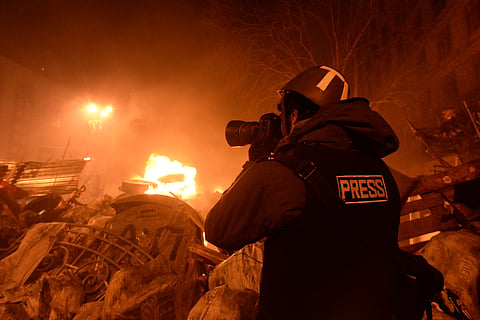Is Southasia really becoming safer for journalists?

Towards the end of 2013, Himal asked whether Southasia was becoming a safer place for journalists. The answer at the time was: "seems to be". This conclusion followed the Committee to Protect Journalists (CPJ)'s statistics on the imprisonment and country-by-country killings of reporters for the year.
In the wake of the Taliban's 20 January attack this year on Afghanistan's TOLO TV network, killing eight of the network's employees, it seems time to revisit our earlier conclusion.
India and Pakistan both saw a journalist killed in 2015 for reasons directly related to their profession, according to figures from the CPJ. Five were killed in Bangladesh that same year. In Afghanistan however, no journalists were killed in 2015 – despite three murders the previous year.
The world leader in killing journalists in 2015 was again Syria, which has held this undesirable position since erupting into conflict in 2012. However despite the deaths of 14 journalists in the country last year, the casualties have fallen from the peak of 31 in 2012. France last year appeared second on CPJ's list, with all eight deaths attributable to the Charlie Hebdo attack.
These numbers merit investigation. The first issue is measurement. CPJ reports the numbers for cases it evaluates as "motive confirmed", meaning the death is either a result of "direct reprisal" or crossfire. Reporters Without Borders (RSF), an independent French NGO, categorises journalist deaths in a similar manner, but reaches different results.
For example, CPJ reported one "motive confirmed" journalist murder out of four total killings in India last year, while RSF reported five confirmed murders out of a total of nine. RSF's figures accordingly put India third in the world for total journalist killings behind Syria and Iraq. Cross-referencing their lists reveals CPJ had one name that RSF seemed to miss. Between the two lists, a total of 10 journalists were killed in India last year, with five confirmed by one or other media NGO to be murders related to their work. The discrepancy between the two reports is a testament to the difficulty and the subjective nature of attempting to classify the motives of a killing.
One journalist killed is obviously one too many, but when the number of deaths are considered relative to the total population, India places an order of magnitude behind other countries on the list. But maybe we do not turn to these annual reports for cold numbers. Establishing a country-wide metric for 'journalist safety' from the aggregate of all these incidents, is no simple measurement. Many incidents in India last year related to crime, mafias and corruption, often at a local community level, and can be several years in the making rather than due to a single story. For example, journalist Sandeep Kothari was falsely accused of numerous crimes over five years, from rape to 'goat theft', in retaliation for his reporting around illegal sand mining. He was kidnapped and killed by a group involved in the 'sand mafia', shortly after he filed a case of illegal mining against this group. CPJ did not consider his case "motive confirmed", but RSF did.
The recent TOLO TV attack might make us fear for a rising culture of violence against journalism in Afghanistan – which had zero journalist killings last year, according to both CPJ and RSF – without needing to reduce this to a statistical value. Instead, we are left with names.
~Sarah Khatry is an intern at Himal Southasian. She is a Physics and English student at Dartmouth College (and laser expert). She is an editor of 40 Towns, a longform student magazine covering New Hampshire and Vermont.

